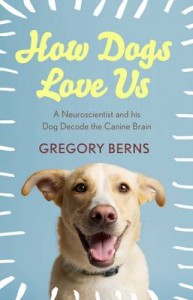Getting a dog to lie still for an MRI is a daunting task. Trying to explain dogs’ love for humans may be an even greater one. Paul O’Connor’s latest listening adventure has been an audio book that tackles those challenges.
Reviewed by Paul T. O’Connor
HOW DOGS LOVE US: A NEUROSCIENTIST AND HIS ADOPTED DOG DECODE THE CANINE BRAIN. By Gregory Berns. Narrated by L.J. Ganser. Audible.com. 7 hours and 41 minutes. $12.57.
Of course he does. Look at how he wags when I get home, or how he follows me around the house at night, even coming up to the man tree house to watch hockey games with me. He’s lying by the window, soaking up the sun right now as I write only 15 feet away.
But does he really love me, understand me, or has he just figured out that I’m the guy who feeds him twice a day?
Neuroscientist Gregory Berns set out to answer a number of questions about dogs and how their brains work, mostly whether our dogs love us. A long-time researcher on the operations of the human brain, he went to work on his terrier mix mutt Callie, using the facilities of Emory University.
This is a fun listen, one very suited to a long afternoon ride in heavy traffic when you’re already missing the family member you had to leave at home with a dog sitter.
Here’s the challenge Berns faced: Find a way to get Callie into an MRI machine and train her to stay perfectly still for about 20 seconds. Given that the machines make a racket and dogs seldom stay still while awake, it was a challenge.
The book is the story of how Berns and his research team designed their project, how they trained Callie and other dogs to cooperate, where they succeeded and where they didn’t.
At the same time, it is the story of the Berns family’s love of their dogs and of the beneficial effect that the research project had on the author’s underachieving middle-school daughter.
For dog lovers, there are a number of ah-hah moments, the times when a new method succeeds in moving the research forward. (We might all learn a thing or two about training our dogs.) The book also serves as an illustration of how scientists conduct neuroscience research.
Even at just under eight hours, the book seems a little long. There’s a lot of stuff that a stronger editor would have condensed. And the narrator’s performance is grating at time, mostly when mimicking the silly dog talk Berns used on Callie. (OK, I talk the same way to Dexter, but no one hears me while stuck in D.C. traffic.)
As for the central question of the book, you shouldn’t have to ask. Of course they love us. You just have to read the book to learn how and why.
